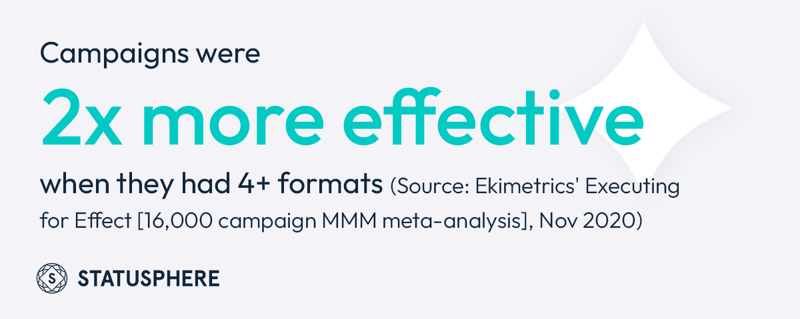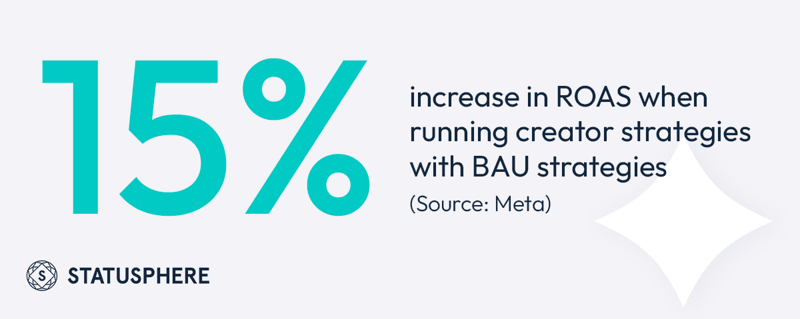
"How can you possibly personalize your ad campaigns with so many new privacy changes?"
This was the main topic of conversation during last week's Personalized Beauty Summit. Fresh from the event, I wanted to share new insights from Meta themselves on how marketers should approach ads in 2022 and beyond.
Allie McIlvaine, Client Solutions Manager at Meta, had the answers in her presentation "How Personalization Can Bring Down Customer Acquisition Costs."
The timing of the talk was perfect given the freefall marketers have felt since the iOS rollout last year. With Google's own privacy crackdown looming, brands are scrambling to create engaging campaigns with less audience data.
Meta's Advice for Balancing Personalization and Privacy Updates
The good news? Meta wasn't shy about sharing tips to future-proof your ad campaigns.
Here are the key takeaways from McIlvaine's talk:
"Campaigns with broad audiences significantly outperform those with tighter targeting."
- Studies show that brands that set broader targeting parameters for ad campaigns perform better. McIlvaine claims that broader targeting allows Meta's AI technology to better match your message to the appropriate audience.
"Creator strategies perform across the funnel."
- According to Meta, brands that run creator-based ad campaigns see a 15% increase in ROAS (return on ad spend) over non-creator campaigns.
"Brands that connect with people across multiple experiences (ex: In-Feed, Reels, Stories) are more effective."
- Meta saw that brands running campaigns across multiple formats were up to 139% more effective at driving awareness, consideration and association.
Later in the presentation, McIlvaine explained:
"The ads ecosystem is rapidly evolving to meet people's expectations around privacy. If businesses can't evolve to meet this moment, ads will begin to lose relevance. Not only does this create a poor experience for people, it increases costs for advertisers."

Let's dig a bit deeper into the presentation and how to translate the takeaways above into action.
1. "Campaigns with broad audiences significantly outperform those with tighter targeting"
McIlvaine kicked things off by highlighting the concept of "liquidity."
She stressed that marketers need to understand liquidity to maximize the efficiency of their ads and Meta's AI. This includes:
- Budget Liquidity. In short, let your budget flow to the best opportunities.
- Placement Liquidity. Meet people where they spend their time and are most likely to convert.
- Audience Liquidity. Empower Meta's platform to find your best audience via broader targeting.
- Creative Liquidity. Develop variable ad creatives (messaging + format) to deliver personalized experiences at scale.
McIlvaine drove home the fact that Facebook built an AI supercomputer with explicit functions to match your marketing messaging and creatives to the most relevant audience. As a result, setting your audience too narrow will limit the system's ability to optimize your campaigns.
Here are a few stats she shared regarding the AI's ability to optimize ad performance:
- "Creative is the single biggest driver of brand salience in digital campaigns" (Source: Kantar Analysis of Crossmedia Database, 2017-2020)
- "Campaigns were 2X more effective when they had 4+ formats" (Source: Ekimetrics' Executing for Effect [16,000 campaign MMM meta-analysis], Nov 2020)
- "11X is the difference in the top and bottom performing creative in an average campaign" (Social Code Facebook Macro Data, 2018)

Translation? Don't be afraid of letting Meta do the legwork of audience targeting. Granted your creatives are on point, access to less granular data doesn't limit your campaigns by default.
2. "Creator strategies perform across the funnel"
The importance of brands incorporating creators in their marketing strategies was at the core of McIlvaine's presentation.
Specifically, how working with creators is a proven way to increase your ROAS. Here are a few notable statistics she shared:
- 63% of people trust creators' opinions of products "much more" than what brands say about themselves
- 58% of consumers bought a new product in the past six months because of a creator's recommendation
- Instagram branded content ads see a +82% probability to win for purchase outcomes (and a -3.9% cost per purchase)
- -8.5% reduction in CPA when running creator strategies with BAU (business as usual) strategies
- 15% increase in ROAS when running creator strategies with BAU strategies
- 130% increase in clickthrough rates when running creator strategies with BAU strategies

The positive impact of creators across' Meta's ad platform speaks for itself. Similarly, this performance boost mirrors the effectiveness of creator-based ad campaigns on TikTok.
3. "Brands that connect with people across multiple experiences are more effective"
McIlvaine also emphasized the importance of running ads and connecting with your audience across multiple experiences.
Given the various ad formats Meta offers between Facebook and Instagram, this can be tough. That said, Reels appear to be the big winner right now in terms of ad performance. Coupled with formats including Stories, Feed, and In-Stream, brands have tons of creative freedom to reach customers.
She wrapped up by sharing some Meta stats highlighting how different ad experiences stood out:
- 80% of Reels are viewed with the sound "on"
- 74% of Facebook In-Stream, non-skippable video ad views are completed, globally
- 70% of surveyed Instagram weekly users prefer to see ads with product tags over ads without product tags
- -33% lower cost per incremental purchase for static ads with product stages compared to static ads without product tags
- Sephora saw an 80% increase in brand favorability with Reels ads, compared to BAU (and a 65% cheaper cost in favorability lift when adding Reels ads)

These numbers signal how modern social ads have transformed the customer journey. As consumers jump seamlessly from organic content and ads across platforms, brands need to be there to meet them.
Have You Future-Proofed Your Brand's Ad Campaigns?
There's no better time than now to put your ad campaigns under the microscope.
As audience data becomes harder to come by, creators are poised to be the difference-makers for brands looking to boost ad engagement and low their customer acquisition costs.
And what I learned from Meta last week goes hand in hand with what we've seen firsthand at Statusphere:
Creator campaigns work.
If you're interested in getting creators talking about your brand, we can help! Talk to one of our consumer-to-consumer marketing specialists today to understand how our full-service platform can give your social campaigns a much-needed boost.
.jpg)